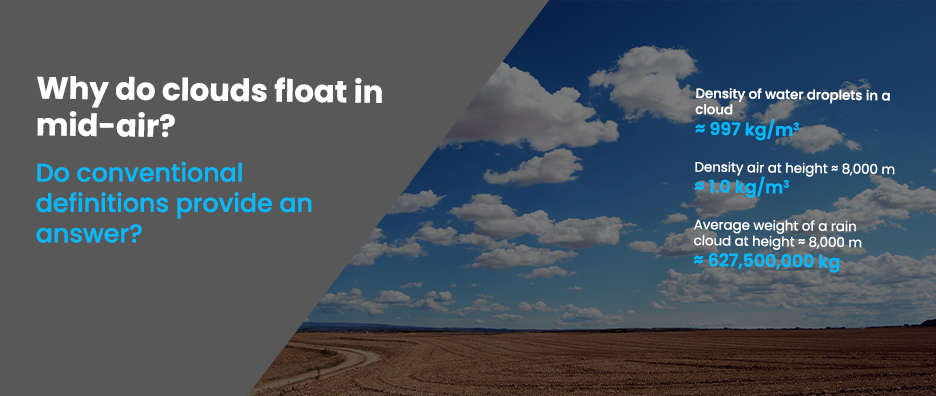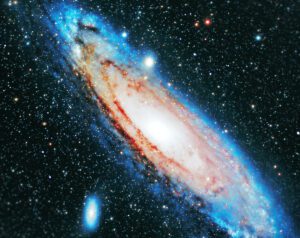

Thermal expansion & State change of matter
Thermal expansion & State change of matter Predominant Existing Theory A given atom may rest in its equilibrium position, r0, i.e., at the minimum of


In meteorology, a cloud is a visible mass of liquid water droplets or frozen crystals. Water is nearly 1000 times denser than air. If so, why does water float in mid-air?
Facts:
On the above facts, it is common to see discussions on why clouds are floating in mid-air. There are no discussions on the cumulative structure (neither collapsing/attracting nor dispersing/repulsing property).
According to the present knowledge of science, there are only two possibilities for clouds to float in mid-air:
1) Buoyancy (Liu et al., 2013) – All fluids (liquid or gas), in the presence of Earth’s gravity, exert an upward force known as the buoyant force on any other substance. Therefore, any substance with lower density would float or rise through a higher density fluid.
The mean average distance among droplets is around 1,000 µm (1 mm) and average droplet diameter (Volume Mean Diameter (VMD)) is ≈10 µm (Igel and van den Heever, 2017). Considering the distance among droplets to their size, there can only be gravitational and electromagnetics forces. Net charge of a cloud in fair weather condition is considered as zero (Allee and Phillips, 1959) and therefore electromagnetic forces among cloud water droplets are negligible. Therefore, droplets in a cloud are independent objects (water entities) in air
(appearing as a cloud). Considering the density ratio, no buoyancy can be expected to support water droplets afloat in mid-air.
2) Updraft – The main argument in cloud physics is that fall of cloud droplets (Day, 2005) (Williams, 1997, Wang, 2013) towards the Earth is counteracted only by updraft (convection currents). See the animated Video 1 below. It is also worth mentioning that there exists a down draft similar to updraft in clouds (Tonttila et al., 2011) (Schmidt et al., 2012).
When the air is too cold to hold all its moisture, mist and fog usually form on a calm night. Volume Mean Diameter (VMD) of fog droplets are observed up to about 65µm (Kumai, 1973) (Lenham and Clay, 1982). In mist the VMD tends to be a little higher than in fog. In other words, mist is heavier and lies closer to the ground. The separation among these droplets is relatively large compared to their size. The number density of these droplets is around 25 droplets per cubic centimeter (Kumai, 1973). Mist and fog, hence, have similar composition as clouds.
Mist and fog form close to the ground level in still (or undisturbed) air where updraft (convection currents) do not exist. This is further observable in still or in slowly moving clouds early in the morning, in high mountains (Video 2) where the ground is cold (in some cases nearly frozen); thus no convection or updraft exists. This implies that updraft is not the cause to hold water droplets in mid-air.
In addition to that, it has been proven (Piyadasa, 2019) that, even if updraft does exist inside a cloud, it is not possible to maintain the water droplets afloat in mid-air by energy (momentum) transfer from air molecules to water droplets – the only fundamental mechanism in energy transfer in classical mechanics. Consider the facts:
Mass of a 10 ![]() μm water droplet = 5 × 10-6 kg
μm water droplet = 5 × 10-6 kg
Mass of an average air molecule = 4.8 × 10-26 kg
Mass of a ![]()
![]()
![]()
Video 1: Animation of the classical concept of floating water droplets in mid-air due to updraft (convection currents)
The floating water droplets in mid air much clearer when considering following two examples.
The natural phenomena, moving clouds moving close to the ground in hill country, Fog and mist, that also called ground level clouds, are also consists of water droplets and the density is 1000 times larger than surrounding air. Those water droplets in Fog and Mist are also floating in midair!
Video 2: Clouds float in mid air without any updraft, close to the ground in hill country


Figure 1. Fog and Mist. Ground level clouds are easily observable to exist with no updraft
The above discussed experimentally verified observations cannot be explained by existing theories! Nevertheless, these observations can easily be explained by assuming a gravitational repulsion force in addition to the gravitational attraction force.
As gravitational attraction is caused by the mass, the gravitational repulsion is caused by the thermal energy. Please see Figure 2.


Above observations of the Nature simply tell us that there is a cryptic force, which acts as a repulsive force against the direction of the gravitational pull (i.e., a repulsive force between the Earth and water droplets in clouds).
References:


Thermal expansion & State change of matter Predominant Existing Theory A given atom may rest in its equilibrium position, r0, i.e., at the minimum of


Accelerating expansion of universe The phenomenon ‘Accelerating Expansion of Universe’ (Perlmutter et al., 1998, Riess et al., 1998) is based on the observation that galaxies


What causes pressure in gases The Existing Model: Pressure is the force exerted by one substance on another per unit area. In the existing model,